Monitor Networkwide Inventory
With the NetQ UI and CLI, a user can monitor the inventory on a networkwide basis for all switches and hosts, or all switches. Inventory includes such items as the number of each device and what operating systems are installed. Additional details are available about the hardware and software components on individual switches, such as the motherboard, ASIC, microprocessor, disk, memory, fan and power supply information. This is extremely useful for understanding the dependence on various vendors and versions when planning upgrades or evaluating the scope of any other required changes.
The commands and cards available to obtain this type of information help you to answer questions such as:
- What switches are being monitored in the network?
- What is the distribution of ASICs, CPUs, Agents, and so forth across my network?
- Do all switches have valid licenses?
- Are NetQ agents running on all of my switches?
- What hardware is installed on my switches?
- What software is installed on my switches?
To monitor the inventory of a given switch, refer to Monitor Switch Inventory.
Access Networkwide Inventory Data
The NetQ UI provides the Inventory|Devices card for monitoring networkwide inventory information for all switches and hosts. The Inventory|Switches card provides a more detailed view of inventory information for all switches (no hosts) on a networkwide basis.
Access these card from the Cumulus Workbench, or add them to your own workbench by clicking (Add card) > Inventory > Inventory|Devices card or Inventory|Switches card > Open Cards.


The NetQ CLI provides detailed network inventory information through its netq show inventory command.
View Networkwide Inventory Summary
All of the devices in your network can be viewed from either the NetQ UI or NetQ CLI.
View the Number of Each Device Type in Your Network
You can view the number of switches and hosts deployed in your network. As you grow your network this can be useful for validating that devices have been added as scheduled.
To view the quantity of devices in your network, locate or open the small or medium Inventory|Devices card. The medium-sized card provide operating system distribution across the network in addition to the device count.

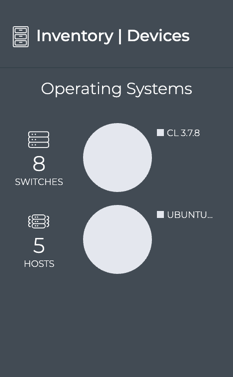
View All Switches
You can view all stored attributes for all switches in your network from either inventory card:
- Open the full-screen Inventory|Devices card and click All Switches

- Open the full-screen Inventory|Switches card and click Show All

To return to your workbench, click in the top right corner of the card.
View All Hosts
You can view all stored attributes for all hosts in your network. To view all host details, open the full screen Inventory|Devices card and click All Hosts.

To return to your workbench, click in the top right corner of the card.
To view a list of devices in your network, run:
netq show inventory brief [json]
This example shows that we have four spine switches, three leaf switches, two border switches, two firewall switches, seven hosts (servers), and an out-of-band management server in this network. For each of these we see the type of switch, operating system, CPU and ASIC.
cumulus@switch:~$ netq show inventory brief
Matching inventory records:
Hostname Switch OS CPU ASIC Ports
----------------- -------------------- --------------- -------- --------------- -----------------------------------
border01 VX CL x86_64 VX N/A
border02 VX CL x86_64 VX N/A
fw1 VX CL x86_64 VX N/A
fw2 VX CL x86_64 VX N/A
leaf01 VX CL x86_64 VX N/A
leaf02 VX CL x86_64 VX N/A
leaf03 VX CL x86_64 VX N/A
oob-mgmt-server N/A Ubuntu x86_64 N/A N/A
server01 N/A Ubuntu x86_64 N/A N/A
server02 N/A Ubuntu x86_64 N/A N/A
server03 N/A Ubuntu x86_64 N/A N/A
server04 N/A Ubuntu x86_64 N/A N/A
server05 N/A Ubuntu x86_64 N/A N/A
server06 N/A Ubuntu x86_64 N/A N/A
server07 N/A Ubuntu x86_64 N/A N/A
spine01 VX CL x86_64 VX N/A
spine02 VX CL x86_64 VX N/A
spine03 VX CL x86_64 VX N/A
spine04 VX CL x86_64 VX N/A
View Networkwide Hardware Inventory
You can view hardware components deployed on all switches and hosts, or on all of the switches in your network.
View Components Summary
It can be useful to know the quantity and ratio of many components deployed in your network to determine the scope of upgrade tasks, balance vendor reliance, or for detailed troubleshooting. Hardware and software component summary information is available from the NetQ UI and NetQ CLI.
- Inventory|Devices card: view ASIC, license, NetQ Agent version, OS, and platform information on all devices
- Inventory|Switches card: view ASIC, CPU, disk, license, NetQ Agent version, OS, and platform information on all switches
netq show inventorycommand: view ASIC, CPU, disk, OS, and ports on all devices
-
Locate the Inventory|Devices card on your workbench.
-
Hover over the card, and change to the large size card using the size picker.
By default the Switches tab is shown displaying the total number of switches, ASIC vendors, OS versions, license status, NetQ Agent versions, and specific platforms deployed across all of your switches.

- Name or value of the component type, such as the version number or status
- Total number of switches with that type of component deployed compared to the total number of switches
- Percentage of this type with respect to all component types

Additionally, sympathetic highlighting is used to show the related component types relevant to the highlighted segment and the number of unique component types associated with this type (shown in blue here).
-
Locate the Inventory|Switches card on your workbench.
-
Hover over any of the segments in the distribution chart to highlight a specific component.
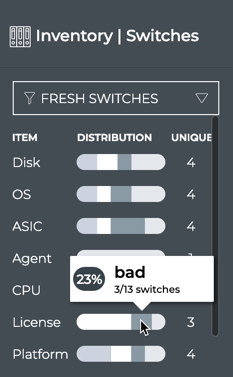
- Name or value of the component type, such as the version number or status
- Total number of switches with that type of component deployed compared to the total number of switches
- Percentage of this type with respect to all component types
- Change to the large size card. The same information is shown separated by hardware and software, and sympathetic highlighting is used to show the related component types relevant to the highlighted segment and the number of unique component types associated with this type (shown in blue here).

To view switch components, run:
netq show inventory brief [json]
This example shows the operating systems (Cumulus Linux and Ubuntu), CPU architecture (all x86_64), ASIC (virtual), and ports (none, since virtual) for each device in the network. You can manually count the number of each of these, or export to a spreadsheet tool to sort and filter the list.
cumulus@switch:~$ netq show inventory brief
Matching inventory records:
Hostname Switch OS CPU ASIC Ports
----------------- -------------------- --------------- -------- --------------- -----------------------------------
border01 VX CL x86_64 VX N/A
border02 VX CL x86_64 VX N/A
fw1 VX CL x86_64 VX N/A
fw2 VX CL x86_64 VX N/A
leaf01 VX CL x86_64 VX N/A
leaf02 VX CL x86_64 VX N/A
leaf03 VX CL x86_64 VX N/A
oob-mgmt-server N/A Ubuntu x86_64 N/A N/A
server01 N/A Ubuntu x86_64 N/A N/A
server02 N/A Ubuntu x86_64 N/A N/A
server03 N/A Ubuntu x86_64 N/A N/A
server04 N/A Ubuntu x86_64 N/A N/A
server05 N/A Ubuntu x86_64 N/A N/A
server06 N/A Ubuntu x86_64 N/A N/A
server07 N/A Ubuntu x86_64 N/A N/A
spine01 VX CL x86_64 VX N/A
spine02 VX CL x86_64 VX N/A
spine03 VX CL x86_64 VX N/A
spine04 VX CL x86_64 VX N/A
View ASIC Information
ASIC information is available from the NetQ UI and NetQ CLI.
- Inventory|Devices card
- Large: view ASIC distribution across all switches (graphic)
- Full-screen: view ASIC vendor, model, model ID, ports, core bandwidth across all devices (table)
- Inventory|Switches card
- Medium/Large: view ASIC distribution across all switches (graphic)
- Full-screen: view ASIC vendor, model, model ID, ports, core bandwidth and data across all switches (table)
netq show inventory asiccommand- View ASIC vendor, model, model ID, core bandwidth, and ports on all devices
-
Locate the medium Inventory|Devices card on your workbench.
-
Hover over the card, and change to the large size card using the size picker.
-
Click a segment of the ASIC graph in the component distribution charts.
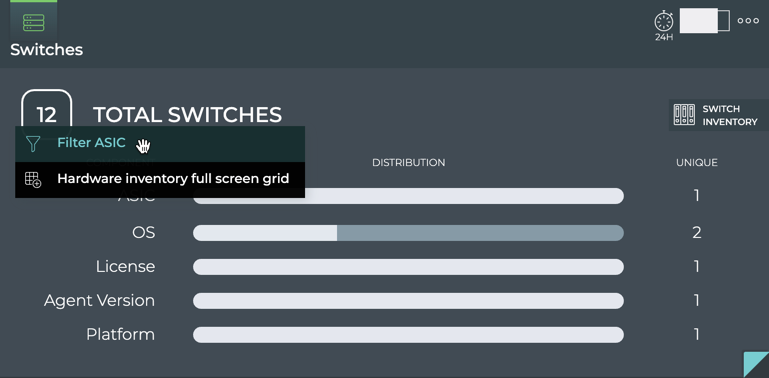
- Select the first option from the popup, Filter ASIC. The card data is filtered to show only the components associated with selected component type. A filter tag appears next to the total number of switches indicating the filter criteria.

- Hover over the segments to view the related components.
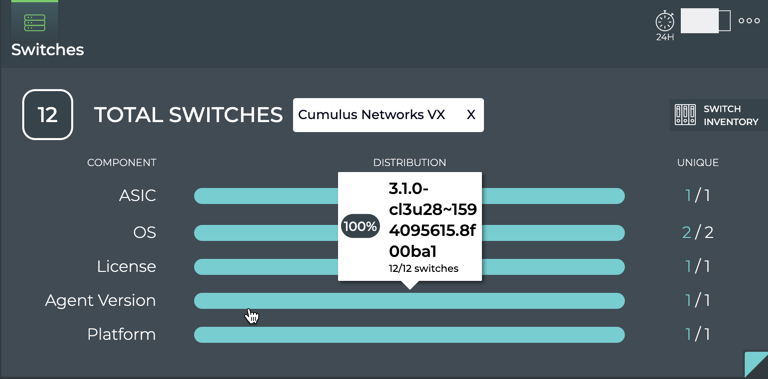
-
To return to the full complement of components, click the
in the filter tag.
-
Hover over the card, and change to the full-screen card using the size picker.

-
Scroll to the right to view the above ASIC information.
-
To return to your workbench, click
in the top right corner of the card.
-
Locate the Inventory|Switches card on your workbench.
-
Hover over a segment of the ASIC graph in the distribution chart.
The same information is available on the summary tab of the large size card.

-
Hover over the card header and click
to view the ASIC vendor and model distribution.
-
Hover over charts to view the name of the ASIC vendors or models, how many switches have that vendor or model deployed, and the percentage of this number compared to the total number of switches.
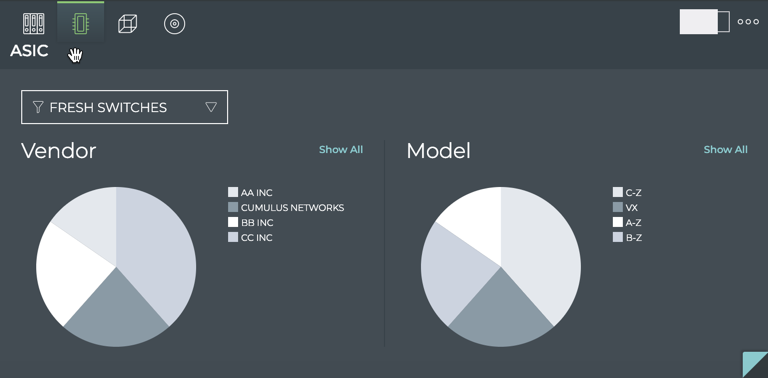
- Change to the full-screen card to view all of the available ASIC information. Note that if you are running CumulusVX switches, no detailed ASIC information is available.

- To return to your workbench, click
in the top right corner of the card.
To view information about the ASIC installed on your devices, run:
netq show inventory asic [vendor <asic-vendor>|model <asic-model>|model-id <asic-model-id>] [json]
If you are running NetQ on a CumulusVX setup, there is no physical hardware to query and thus no ASIC information to display.
This example shows the ASIC information for all devices in your network:
cumulus@switch:~$ netq show inventory asic
Matching inventory records:
Hostname Vendor Model Model ID Core BW Ports
----------------- -------------------- ------------------------------ ------------------------- -------------- -----------------------------------
dell-z9100-05 Broadcom Tomahawk BCM56960 2.0T 32 x 100G-QSFP28
mlx-2100-05 Mellanox Spectrum MT52132 N/A 16 x 100G-QSFP28
mlx-2410a1-05 Mellanox Spectrum MT52132 N/A 48 x 25G-SFP28 & 8 x 100G-QSFP28
mlx-2700-11 Mellanox Spectrum MT52132 N/A 32 x 100G-QSFP28
qct-ix1-08 Broadcom Tomahawk BCM56960 2.0T 32 x 100G-QSFP28
qct-ix7-04 Broadcom Trident3 BCM56870 N/A 32 x 100G-QSFP28
st1-l1 Broadcom Trident2 BCM56854 720G 48 x 10G-SFP+ & 6 x 40G-QSFP+
st1-l2 Broadcom Trident2 BCM56854 720G 48 x 10G-SFP+ & 6 x 40G-QSFP+
st1-l3 Broadcom Trident2 BCM56854 720G 48 x 10G-SFP+ & 6 x 40G-QSFP+
st1-s1 Broadcom Trident2 BCM56850 960G 32 x 40G-QSFP+
st1-s2 Broadcom Trident2 BCM56850 960G 32 x 40G-QSFP+
You can filter the results of the command to view devices with a particular vendor, model, or modelID. This example shows ASIC information for all devices with a vendor of NVIDIA.
cumulus@switch:~$ netq show inventory asic vendor NVIDIA
Matching inventory records:
Hostname Vendor Model Model ID Core BW Ports
----------------- -------------------- ------------------------------ ------------------------- -------------- -----------------------------------
mlx-2100-05 NVIDIA Spectrum MT52132 N/A 16 x 100G-QSFP28
mlx-2410a1-05 NVIDIA Spectrum MT52132 N/A 48 x 25G-SFP28 & 8 x 100G-QSFP28
mlx-2700-11 NVIDIA Spectrum MT52132 N/A 32 x 100G-QSFP28
View Motherboard/Platform Information
Motherboard and platform information is available from the NetQ UI and NetQ CLI.
- Inventory|Devices card
- Full-screen: view platform vendor, model, manufacturing date, revision, serial number, MAC address, series across all devices (table)
- Inventory|Switches card
- Medium/Large: view platform distribution across on all switches (graphic)
- Full-screen: view platform vendor, model, manufacturing date, revision, serial number, MAC address, series across all switches (table)
netq show inventory boardcommand- View motherboard vendor, model, base MAC address, serial number, part number, revision, and manufacturing date on all devices
-
Locate the Inventory|Devices card on your workbench.
-
Hover over the card, and change to the full-screen card using the size picker.
-
The All Switches tab is selected by default. Scroll to the right to view the various Platform parameters for your switches. Optionally drag and drop the relevant columns next to each other.

-
Click All Hosts.
-
Scroll to the right to view the various Platform parameters for your hosts. Optionally drag and drop the relevant columns next to each other.

To return to your workbench, click in the top right corner of the card.
-
Locate the Inventory|Switches card on your workbench.
-
Hover over the card, and change to the large card using the size picker.
-
Hover over the header and click
 .
.
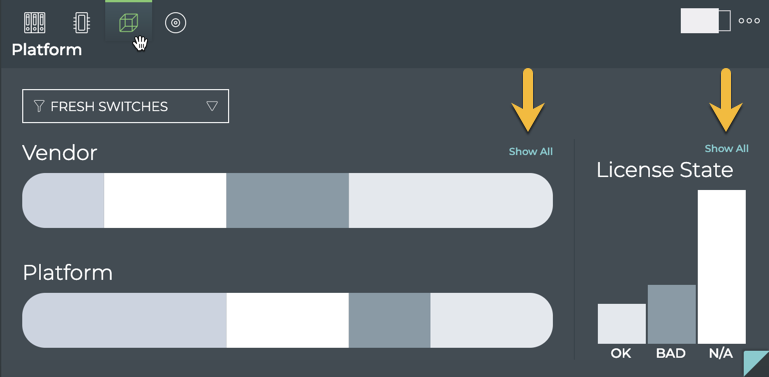
-
Hover over a segment in the Vendor or Platform graphic to view how many switches deploy the specified vendor or platform.
Context sensitive highlighting is also employed here, such that when you select a vendor, the corresponding platforms are also highlighted; and vice versa. Note that you can also see the status of the Cumulus Linux license for each switch.
-
Click either Show All link to open the full-screen card.
-
Click Platform.

- To return to your workbench, click
in the top right corner of the card.
To view a list of motherboards installed in your switches and hosts, run:
netq show inventory board [vendor <board-vendor>|model <board-model>] [json]
This example shows all of the motherboard data for all devices.
cumulus@switch:~$ netq show inventory board
Matching inventory records:
Hostname Vendor Model Base MAC Serial No Part No Rev Mfg Date
----------------- -------------------- ------------------------------ ------------------ ------------------------- ---------------- ------ ----------
dell-z9100-05 DELL Z9100-ON 4C:76:25:E7:42:C0 CN03GT5N779315C20001 03GT5N A00 12/04/2015
mlx-2100-05 Penguin Arctica 1600cs 7C:FE:90:F5:61:C0 MT1623X10078 MSN2100-CB2FO N/A 06/09/2016
mlx-2410a1-05 Mellanox SN2410 EC:0D:9A:4E:55:C0 MT1734X00067 MSN2410-CB2F_QP3 N/A 08/24/2017
mlx-2700-11 Penguin Arctica 3200cs 44:38:39:00:AB:80 MT1604X21036 MSN2700-CS2FO N/A 01/31/2016
qct-ix1-08 QCT QuantaMesh BMS T7032-IX1 54:AB:3A:78:69:51 QTFCO7623002C 1IX1UZZ0ST6 H3B 05/30/2016
qct-ix7-04 QCT IX7 D8:C4:97:62:37:65 QTFCUW821000A 1IX7UZZ0ST5 B3D 05/07/2018
qct-ix7-04 QCT T7032-IX7 D8:C4:97:62:37:65 QTFCUW821000A 1IX7UZZ0ST5 B3D 05/07/2018
st1-l1 CELESTICA Arctica 4806xp 00:E0:EC:27:71:37 D2060B2F044919GD000011 R0854-F1004-01 Redsto 09/20/2014
ne-XP
st1-l2 CELESTICA Arctica 4806xp 00:E0:EC:27:6B:3A D2060B2F044919GD000060 R0854-F1004-01 Redsto 09/20/2014
ne-XP
st1-l3 Penguin Arctica 4806xp 44:38:39:00:70:49 N/A N/A N/A N/A
st1-s1 Dell S6000-ON 44:38:39:00:80:00 N/A N/A N/A N/A
st1-s2 Dell S6000-ON 44:38:39:00:80:81 N/A N/A N/A N/A
You can filter the results of the command to capture only those devices with a particular motherboard vendor or model. This example shows only the devices with a Celestica motherboard.
cumulus@switch:~$ netq show inventory board vendor celestica
Matching inventory records:
Hostname Vendor Model Base MAC Serial No Part No Rev Mfg Date
----------------- -------------------- ------------------------------ ------------------ ------------------------- ---------------- ------ ----------
st1-l1 CELESTICA Arctica 4806xp 00:E0:EC:27:71:37 D2060B2F044919GD000011 R0854-F1004-01 Redsto 09/20/2014
ne-XP
st1-l2 CELESTICA Arctica 4806xp 00:E0:EC:27:6B:3A D2060B2F044919GD000060 R0854-F1004-01 Redsto 09/20/2014
ne-XP
View CPU Information
CPU information is available from the NetQ UI and NetQ CLI.
- Inventory|Devices card
- Full-screen: view CPU architecture, model, maximum operating frequency, and the number of cores on all devices (table)
- Inventory|Switches card
- Medium/Large: view CPU distribution across on all switches (graphic)
- Full-screen: view CPU architecture, model, maximum operating frequency, the number of cores, and data on all switches (table)
netq show inventory cpucommand- View CPU architecture, model, maximum operating frequency, and the number of cores on all devices
-
Locate the Inventory|Devices card on your workbench.
-
Hover over the card, and change to the full-screen card using the size picker.
-
The All Switches tab is selected by default. Scroll to the right to view the various CPU parameters. Optionally drag and drop relevant columns next to each other.

- Click All Hosts to view the CPU information for your host servers.

- To return to your workbench, click
in the top right corner of the card.
-
Locate the Inventory|Switches card on your workbench.
-
Hover over a segment of the CPU graph in the distribution chart.
The same information is available on the summary tab of the large size card.

-
Hover over the card, and change to the full-screen card using the size picker.
-
Click CPU.

- To return to your workbench, click
in the top right corner of the card.
To view CPU information for all devices in your network, run:
netq show inventory cpu [arch <cpu-arch>] [json]
This example shows the CPU information for all devices.
cumulus@switch:~$ netq show inventory cpu
Matching inventory records:
Hostname Arch Model Freq Cores
----------------- -------- ------------------------------ ---------- -----
dell-z9100-05 x86_64 Intel(R) Atom(TM) C2538 2.40GHz 4
mlx-2100-05 x86_64 Intel(R) Atom(TM) C2558 2.40GHz 4
mlx-2410a1-05 x86_64 Intel(R) Celeron(R) 1047UE 1.40GHz 2
mlx-2700-11 x86_64 Intel(R) Celeron(R) 1047UE 1.40GHz 2
qct-ix1-08 x86_64 Intel(R) Atom(TM) C2558 2.40GHz 4
qct-ix7-04 x86_64 Intel(R) Atom(TM) C2558 2.40GHz 4
st1-l1 x86_64 Intel(R) Atom(TM) C2538 2.41GHz 4
st1-l2 x86_64 Intel(R) Atom(TM) C2538 2.41GHz 4
st1-l3 x86_64 Intel(R) Atom(TM) C2538 2.40GHz 4
st1-s1 x86_64 Intel(R) Atom(TM) S1220 1.60GHz 4
st1-s2 x86_64 Intel(R) Atom(TM) S1220 1.60GHz 4
You can filter the results of the command to view which switches employ a particular CPU architecture using the arch keyword. This example shows how to determine which architectures are deployed in your network, and then shows all devices with an x86_64 architecture.
cumulus@switch:~$ netq show inventory cpu arch
x86_64 : CPU Architecture
cumulus@switch:~$ netq show inventory cpu arch x86_64
Matching inventory records:
Hostname Arch Model Freq Cores
----------------- -------- ------------------------------ ---------- -----
leaf01 x86_64 Intel Core i7 9xx (Nehalem Cla N/A 1
ss Core i7)
leaf02 x86_64 Intel Core i7 9xx (Nehalem Cla N/A 1
ss Core i7)
leaf03 x86_64 Intel Core i7 9xx (Nehalem Cla N/A 1
ss Core i7)
leaf04 x86_64 Intel Core i7 9xx (Nehalem Cla N/A 1
ss Core i7)
oob-mgmt-server x86_64 Intel Core i7 9xx (Nehalem Cla N/A 1
ss Core i7)
server01 x86_64 Intel Core i7 9xx (Nehalem Cla N/A 1
ss Core i7)
server02 x86_64 Intel Core i7 9xx (Nehalem Cla N/A 1
ss Core i7)
server03 x86_64 Intel Core i7 9xx (Nehalem Cla N/A 1
ss Core i7)
server04 x86_64 Intel Core i7 9xx (Nehalem Cla N/A 1
ss Core i7)
spine01 x86_64 Intel Core i7 9xx (Nehalem Cla N/A 1
ss Core i7)
spine02 x86_64 Intel Core i7 9xx (Nehalem Cla N/A 1
ss Core i7)
View Disk Information
Disk information is available from the NetQ UI and NetQ CLI.
- Inventory|Devices card
- Full-screen: view the size of the disk on all devices (table)
- Inventory|Switches card
- Medium/Large: view Disk distribution across on all switches (graphic)
- Full-screen: view disk vendor, size, revision, model, name, transport, and type on all switches (table)
netq show inventory diskcommand- View disk name, type, transport, size, vendor, and model on all devices
-
Locate the Inventory|Devices card on your workbench.
-
Hover over the card, and change to the full-screen card using the size picker.

-
The All Switches tab is selected by default. Locate the Disk Total Size column.
-
Click All Hosts to view the total disk size of all host servers.

- To return to your workbench, click
in the top right corner of the card.
-
Locate the Inventory|Switches card on your workbench.
-
Hover over a segment of the disk graph in the distribution chart.
The same information is available on the summary tab of the large size card.

-
Hover over the card, and change to the full-screen card using the size picker.
-
Click Disk.

- To return to your workbench, click
in the top right corner of the card.
To view disk information for your switches, run:
netq show inventory disk [name <disk-name>|transport <disk-transport>|vendor <disk-vendor>] [json]
This example shows the disk information for all devices.
cumulus@switch:~$ netq show inventory disk
Matching inventory records:
Hostname Name Type Transport Size Vendor Model
----------------- --------------- ---------------- ------------------ ---------- -------------------- ------------------------------
leaf01 vda disk N/A 6G 0x1af4 N/A
leaf02 vda disk N/A 6G 0x1af4 N/A
leaf03 vda disk N/A 6G 0x1af4 N/A
leaf04 vda disk N/A 6G 0x1af4 N/A
oob-mgmt-server vda disk N/A 256G 0x1af4 N/A
server01 vda disk N/A 301G 0x1af4 N/A
server02 vda disk N/A 301G 0x1af4 N/A
server03 vda disk N/A 301G 0x1af4 N/A
server04 vda disk N/A 301G 0x1af4 N/A
spine01 vda disk N/A 6G 0x1af4 N/A
spine02 vda disk N/A 6G 0x1af4 N/A
View Memory Information
Memory information is available from the NetQ UI and NetQ CLI.
- Inventory|Devices card
- Full-screen: view the size of the memory on all devices (table)
- Inventory|Switches card
- Medium/Large: view the memory size distribution across all switches (graphic)
- Full-screen: view memory chip vendor, name, serial number, size, speed, and type on all switches (table)
netq show inventory memory- View memory chip name, type, size, speed, vendor, and serial number on all devices
-
Locate the Inventory|Devices card on your workbench.
-
Hover over the card, and change to the full-screen card using the size picker.

-
The All Switches tab is selected by default. Locate the Memory Size column.
-
Click All Hosts to view the memory size for all host servers.

- To return to your workbench, click
in the top right corner of the card.
-
Locate the medium Inventory|Switches card on your workbench.
-
Hover over a segment of the memory graph in the distribution chart.
The same information is available on the summary tab of the large size card.

-
Hover over the card, and change to the full-screen card using the size picker.
-
Click Memory.
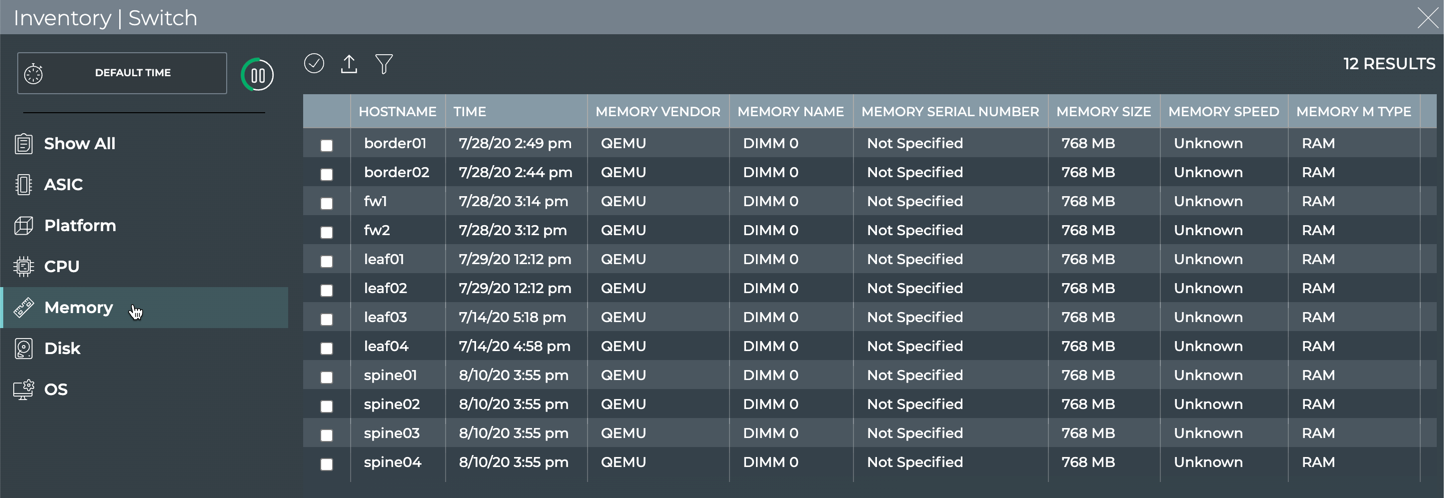
- To return to your workbench, click
in the top right corner of the card.
To view memory information for your switches and host servers, run:
netq show inventory memory [type <memory-type>|vendor <memory-vendor>] [json]
This example shows all of the memory characteristics for all devices.
cumulus@switch:~$ netq show inventory memory
Matching inventory records:
Hostname Name Type Size Speed Vendor Serial No
----------------- --------------- ---------------- ---------- ---------- -------------------- -------------------------
dell-z9100-05 DIMM0 BANK 0 DDR3 8192 MB 1600 MHz Hynix 14391421
mlx-2100-05 DIMM0 BANK 0 DDR3 8192 MB 1600 MHz InnoDisk Corporation 00000000
mlx-2410a1-05 ChannelA-DIMM0 DDR3 8192 MB 1600 MHz 017A 87416232
BANK 0
mlx-2700-11 ChannelA-DIMM0 DDR3 8192 MB 1600 MHz 017A 73215444
BANK 0
mlx-2700-11 ChannelB-DIMM0 DDR3 8192 MB 1600 MHz 017A 73215444
BANK 2
qct-ix1-08 N/A N/A 7907.45MB N/A N/A N/A
qct-ix7-04 DIMM0 BANK 0 DDR3 8192 MB 1600 MHz Transcend 00211415
st1-l1 DIMM0 BANK 0 DDR3 4096 MB 1333 MHz N/A N/A
st1-l2 DIMM0 BANK 0 DDR3 4096 MB 1333 MHz N/A N/A
st1-l3 DIMM0 BANK 0 DDR3 4096 MB 1600 MHz N/A N/A
st1-s1 A1_DIMM0 A1_BAN DDR3 8192 MB 1333 MHz A1_Manufacturer0 A1_SerNum0
K0
st1-s2 A1_DIMM0 A1_BAN DDR3 8192 MB 1333 MHz A1_Manufacturer0 A1_SerNum0
K0
You can filter the results of the command to view devices with a particular memory type or vendor. This example shows all of the devices with memory from QEMU .
cumulus@switch:~$ netq show inventory memory vendor QEMU
Matching inventory records:
Hostname Name Type Size Speed Vendor Serial No
----------------- --------------- ---------------- ---------- ---------- -------------------- -------------------------
leaf01 DIMM 0 RAM 1024 MB Unknown QEMU Not Specified
leaf02 DIMM 0 RAM 1024 MB Unknown QEMU Not Specified
leaf03 DIMM 0 RAM 1024 MB Unknown QEMU Not Specified
leaf04 DIMM 0 RAM 1024 MB Unknown QEMU Not Specified
oob-mgmt-server DIMM 0 RAM 4096 MB Unknown QEMU Not Specified
server01 DIMM 0 RAM 512 MB Unknown QEMU Not Specified
server02 DIMM 0 RAM 512 MB Unknown QEMU Not Specified
server03 DIMM 0 RAM 512 MB Unknown QEMU Not Specified
server04 DIMM 0 RAM 512 MB Unknown QEMU Not Specified
spine01 DIMM 0 RAM 1024 MB Unknown QEMU Not Specified
spine02 DIMM 0 RAM 1024 MB Unknown QEMU Not Specified
View Sensor Information
Fan, power supply unit (PSU), and temperature sensors are available to provide additional data about the NetQ system operation.
Sensor information is available from the NetQ UI and NetQ CLI.
- PSU Sensor card: view sensor name, current/previous state, input/output power, and input/output voltage on all devices (table)
- Fan Sensor card: view sensor name, description, current/maximum/minimum speed, and current/previous state on all devices (table)
- Temperature Sensor card: view sensor name, description, minimum/maximum threshold, current/critical(maximum)/lower critical (minimum) threshold, and current/previous state on all devices (table)
netq show sensors: view sensor name, description, current state, and time when data was last changed on all devices for all or one sensor type
Power Supply Unit Information
- Click
(main menu), then click Sensors in the Network heading.

- The PSU tab is displayed by default.

| PSU Parameter | Description |
|---|---|
| Hostname | Name of the switch or host where the power supply is installed |
| Timestamp | Date and time the data was captured |
| Message Type | Type of sensor message; always PSU in this table |
| PIn(W) | Input power (Watts) for the PSU on the switch or host |
| POut(W) | Output power (Watts) for the PSU on the switch or host |
| Sensor Name | User-defined name for the PSU |
| Previous State | State of the PSU when data was captured in previous window |
| State | State of the PSU when data was last captured |
| VIn(V) | Input voltage (Volts) for the PSU on the switch or host |
| VOut(V) | Output voltage (Volts) for the PSU on the switch or host |
- To return to your workbench, click
in the top right corner of the card.
Fan Information
-
Click
(main menu), then click Sensors in the Network heading.
-
Click Fan.

| Fan Parameter | Description |
|---|---|
| Hostname | Name of the switch or host where the fan is installed |
| Timestamp | Date and time the data was captured |
| Message Type | Type of sensor message; always Fan in this table |
| Description | User specified description of the fan |
| Speed (RPM) | Revolution rate of the fan (revolutions per minute) |
| Max | Maximum speed (RPM) |
| Min | Minimum speed (RPM) |
| Message | Message |
| Sensor Name | User-defined name for the fan |
| Previous State | State of the fan when data was captured in previous window |
| State | State of the fan when data was last captured |
- To return to your workbench, click
in the top right corner of the card.
Temperature Information
-
Click
(main menu), then click Sensors in the Network heading.
-
Click Temperature.

| Temperature Parameter | Description |
|---|---|
| Hostname | Name of the switch or host where the temperature sensor is installed |
| Timestamp | Date and time the data was captured |
| Message Type | Type of sensor message; always Temp in this table |
| Critical | Current critical maximum temperature (°C) threshold setting |
| Description | User specified description of the temperature sensor |
| Lower Critical | Current critical minimum temperature (°C) threshold setting |
| Max | Maximum temperature threshold setting |
| Min | Minimum temperature threshold setting |
| Message | Message |
| Sensor Name | User-defined name for the temperature sensor |
| Previous State | State of the fan when data was captured in previous window |
| State | State of the fan when data was last captured |
| Temperature(Celsius) | Current temperature (°C) measured by sensor |
- To return to your workbench, click
in the top right corner of the card.
View All Sensor Information
To view information for power supplies, fans, and temperature sensors on all switches and host servers, run:
netq show sensors all [around <text-time>] [json]
Use the around option to view sensor information for a time in the past.
This example shows all of the sensors on all devices.
cumulus@switch:~$ netq show sensors all
Matching sensors records:
Hostname Name Description State Message Last Changed
----------------- --------------- ----------------------------------- ---------- ----------------------------------- -------------------------
border01 fan5 fan tray 3, fan 1 ok Fri Aug 21 18:51:11 2020
border01 fan6 fan tray 3, fan 2 ok Fri Aug 21 18:51:11 2020
border01 fan1 fan tray 1, fan 1 ok Fri Aug 21 18:51:11 2020
...
fw1 fan2 fan tray 1, fan 2 ok Thu Aug 20 19:16:12 2020
...
fw2 fan3 fan tray 2, fan 1 ok Thu Aug 20 19:14:47 2020
...
leaf01 psu2fan1 psu2 fan ok Fri Aug 21 16:14:22 2020
...
leaf02 fan3 fan tray 2, fan 1 ok Fri Aug 21 16:14:14 2020
...
leaf03 fan2 fan tray 1, fan 2 ok Fri Aug 21 09:37:45 2020
...
leaf04 psu1fan1 psu1 fan ok Fri Aug 21 09:17:02 2020
...
spine01 psu2fan1 psu2 fan ok Fri Aug 21 05:54:14 2020
...
spine02 fan2 fan tray 1, fan 2 ok Fri Aug 21 05:54:39 2020
...
spine03 fan4 fan tray 2, fan 2 ok Fri Aug 21 06:00:52 2020
...
spine04 fan2 fan tray 1, fan 2 ok Fri Aug 21 05:54:09 2020
...
border01 psu1temp1 psu1 temp sensor ok Fri Aug 21 18:51:11 2020
border01 temp2 board sensor near virtual switch ok Fri Aug 21 18:51:11 2020
border01 temp3 board sensor at front left corner ok Fri Aug 21 18:51:11 2020
...
border02 temp1 board sensor near cpu ok Fri Aug 21 18:46:05 2020
...
fw1 temp4 board sensor at front right corner ok Thu Aug 20 19:16:12 2020
...
fw2 temp5 board sensor near fan ok Thu Aug 20 19:14:47 2020
...
leaf01 psu1temp1 psu1 temp sensor ok Fri Aug 21 16:14:22 2020
...
leaf02 temp5 board sensor near fan ok Fri Aug 21 16:14:14 2020
...
leaf03 psu2temp1 psu2 temp sensor ok Fri Aug 21 09:37:45 2020
...
leaf04 temp4 board sensor at front right corner ok Fri Aug 21 09:17:02 2020
...
spine01 psu1temp1 psu1 temp sensor ok Fri Aug 21 05:54:14 2020
...
spine02 temp3 board sensor at front left corner ok Fri Aug 21 05:54:39 2020
...
spine03 temp1 board sensor near cpu ok Fri Aug 21 06:00:52 2020
...
spine04 temp3 board sensor at front left corner ok Fri Aug 21 05:54:09 2020
...
border01 psu1 N/A ok Fri Aug 21 18:51:11 2020
border01 psu2 N/A ok Fri Aug 21 18:51:11 2020
border02 psu1 N/A ok Fri Aug 21 18:46:05 2020
border02 psu2 N/A ok Fri Aug 21 18:46:05 2020
fw1 psu1 N/A ok Thu Aug 20 19:16:12 2020
fw1 psu2 N/A ok Thu Aug 20 19:16:12 2020
fw2 psu1 N/A ok Thu Aug 20 19:14:47 2020
fw2 psu2 N/A ok Thu Aug 20 19:14:47 2020
leaf01 psu1 N/A ok Fri Aug 21 16:14:22 2020
leaf01 psu2 N/A ok Fri Aug 21 16:14:22 2020
leaf02 psu1 N/A ok Fri Aug 21 16:14:14 2020
leaf02 psu2 N/A ok Fri Aug 21 16:14:14 2020
leaf03 psu1 N/A ok Fri Aug 21 09:37:45 2020
leaf03 psu2 N/A ok Fri Aug 21 09:37:45 2020
leaf04 psu1 N/A ok Fri Aug 21 09:17:02 2020
leaf04 psu2 N/A ok Fri Aug 21 09:17:02 2020
spine01 psu1 N/A ok Fri Aug 21 05:54:14 2020
spine01 psu2 N/A ok Fri Aug 21 05:54:14 2020
spine02 psu1 N/A ok Fri Aug 21 05:54:39 2020
spine02 psu2 N/A ok Fri Aug 21 05:54:39 2020
spine03 psu1 N/A ok Fri Aug 21 06:00:52 2020
spine03 psu2 N/A ok Fri Aug 21 06:00:52 2020
spine04 psu1 N/A ok Fri Aug 21 05:54:09 2020
spine04 psu2 N/A ok Fri Aug 21 05:54:09 2020
View Only Power Supply Sensors
To view information from all PSU sensors or PSU sensors with a given name on your switches and host servers, run:
netq show sensors psu [<psu-name>] [around <text-time>] [json]
Use the psu-name option to view all PSU sensors with a particular name. Use the around option to view sensor information for a time in the past.
Use Tab completion to determine the names of the PSUs in your switches.
cumulus@switch:~$ netq show sensors psu <press tab>
around : Go back in time to around ...
json : Provide output in JSON
psu1 : Power Supply
psu2 : Power Supply
<ENTER>
This example shows information from all PSU sensors on all switches and hosts.
cumulus@switch:~$ netq show sensor psu
Matching sensors records:
Hostname Name State Pin(W) Pout(W) Vin(V) Vout(V) Message Last Changed
----------------- --------------- ---------- ------------ -------------- ------------ -------------- ----------------------------------- -------------------------
border01 psu1 ok Tue Aug 25 21:45:21 2020
border01 psu2 ok Tue Aug 25 21:45:21 2020
border02 psu1 ok Tue Aug 25 21:39:36 2020
border02 psu2 ok Tue Aug 25 21:39:36 2020
fw1 psu1 ok Wed Aug 26 00:08:01 2020
fw1 psu2 ok Wed Aug 26 00:08:01 2020
fw2 psu1 ok Wed Aug 26 00:02:13 2020
fw2 psu2 ok Wed Aug 26 00:02:13 2020
leaf01 psu1 ok Wed Aug 26 16:14:41 2020
leaf01 psu2 ok Wed Aug 26 16:14:41 2020
leaf02 psu1 ok Wed Aug 26 16:14:08 2020
leaf02 psu2 ok Wed Aug 26 16:14:08 2020
leaf03 psu1 ok Wed Aug 26 14:41:57 2020
leaf03 psu2 ok Wed Aug 26 14:41:57 2020
leaf04 psu1 ok Wed Aug 26 14:20:22 2020
leaf04 psu2 ok Wed Aug 26 14:20:22 2020
spine01 psu1 ok Wed Aug 26 10:53:17 2020
spine01 psu2 ok Wed Aug 26 10:53:17 2020
spine02 psu1 ok Wed Aug 26 10:54:07 2020
spine02 psu2 ok Wed Aug 26 10:54:07 2020
spine03 psu1 ok Wed Aug 26 11:00:44 2020
spine03 psu2 ok Wed Aug 26 11:00:44 2020
spine04 psu1 ok Wed Aug 26 10:52:00 2020
spine04 psu2 ok Wed Aug 26 10:52:00 2020
This example shows all PSUs with the name psu2.
cumulus@switch:~$ netq show sensors psu psu2
Matching sensors records:
Hostname Name State Message Last Changed
----------------- --------------- ---------- ----------------------------------- -------------------------
exit01 psu2 ok Fri Apr 19 16:01:17 2019
exit02 psu2 ok Fri Apr 19 16:01:33 2019
leaf01 psu2 ok Sun Apr 21 20:07:12 2019
leaf02 psu2 ok Fri Apr 19 16:01:41 2019
leaf03 psu2 ok Fri Apr 19 16:01:44 2019
leaf04 psu2 ok Fri Apr 19 16:01:36 2019
spine01 psu2 ok Fri Apr 19 16:01:52 2019
spine02 psu2 ok Fri Apr 19 16:01:08 2019
View Only Fan Sensors
To view information from all fan sensors or fan sensors with a given name on your switches and host servers, run:
netq show sensors fan [<fan-name>] [around <text-time>] [json]
Use the around option to view sensor information for a time in the past.
Use tab completion to determine the names of the fans in your switches:
cumulus@switch:~$ netq show sensors fan <<press tab>>
around : Go back in time to around ...
fan1 : Fan Name
fan2 : Fan Name
fan3 : Fan Name
fan4 : Fan Name
fan5 : Fan Name
fan6 : Fan Name
json : Provide output in JSON
psu1fan1 : Fan Name
psu2fan1 : Fan Name
<ENTER>
This example shows the state of all fans.
cumulus@switch:~$ netq show sensor fan
Matching sensors records:
Hostname Name Description State Speed Max Min Message Last Changed
----------------- --------------- ----------------------------------- ---------- ---------- -------- -------- ----------------------------------- -------------------------
border01 fan5 fan tray 3, fan 1 ok 2500 29000 2500 Tue Aug 25 21:45:21 2020
border01 fan6 fan tray 3, fan 2 ok 2500 29000 2500 Tue Aug 25 21:45:21 2020
border01 fan1 fan tray 1, fan 1 ok 2500 29000 2500 Tue Aug 25 21:45:21 2020
border01 fan4 fan tray 2, fan 2 ok 2500 29000 2500 Tue Aug 25 21:45:21 2020
border01 psu1fan1 psu1 fan ok 2500 29000 2500 Tue Aug 25 21:45:21 2020
border01 fan3 fan tray 2, fan 1 ok 2500 29000 2500 Tue Aug 25 21:45:21 2020
border01 fan2 fan tray 1, fan 2 ok 2500 29000 2500 Tue Aug 25 21:45:21 2020
border01 psu2fan1 psu2 fan ok 2500 29000 2500 Tue Aug 25 21:45:21 2020
border02 fan2 fan tray 1, fan 2 ok 2500 29000 2500 Tue Aug 25 21:39:36 2020
border02 psu2fan1 psu2 fan ok 2500 29000 2500 Tue Aug 25 21:39:36 2020
border02 psu1fan1 psu1 fan ok 2500 29000 2500 Tue Aug 25 21:39:36 2020
border02 fan4 fan tray 2, fan 2 ok 2500 29000 2500 Tue Aug 25 21:39:36 2020
border02 fan1 fan tray 1, fan 1 ok 2500 29000 2500 Tue Aug 25 21:39:36 2020
border02 fan6 fan tray 3, fan 2 ok 2500 29000 2500 Tue Aug 25 21:39:36 2020
border02 fan5 fan tray 3, fan 1 ok 2500 29000 2500 Tue Aug 25 21:39:36 2020
border02 fan3 fan tray 2, fan 1 ok 2500 29000 2500 Tue Aug 25 21:39:36 2020
fw1 fan2 fan tray 1, fan 2 ok 2500 29000 2500 Wed Aug 26 00:08:01 2020
fw1 fan5 fan tray 3, fan 1 ok 2500 29000 2500 Wed Aug 26 00:08:01 2020
fw1 psu1fan1 psu1 fan ok 2500 29000 2500 Wed Aug 26 00:08:01 2020
fw1 fan4 fan tray 2, fan 2 ok 2500 29000 2500 Wed Aug 26 00:08:01 2020
fw1 fan3 fan tray 2, fan 1 ok 2500 29000 2500 Wed Aug 26 00:08:01 2020
fw1 psu2fan1 psu2 fan ok 2500 29000 2500 Wed Aug 26 00:08:01 2020
fw1 fan6 fan tray 3, fan 2 ok 2500 29000 2500 Wed Aug 26 00:08:01 2020
fw1 fan1 fan tray 1, fan 1 ok 2500 29000 2500 Wed Aug 26 00:08:01 2020
fw2 fan3 fan tray 2, fan 1 ok 2500 29000 2500 Wed Aug 26 00:02:13 2020
fw2 psu2fan1 psu2 fan ok 2500 29000 2500 Wed Aug 26 00:02:13 2020
fw2 fan2 fan tray 1, fan 2 ok 2500 29000 2500 Wed Aug 26 00:02:13 2020
fw2 fan6 fan tray 3, fan 2 ok 2500 29000 2500 Wed Aug 26 00:02:13 2020
fw2 fan1 fan tray 1, fan 1 ok 2500 29000 2500 Wed Aug 26 00:02:13 2020
fw2 fan4 fan tray 2, fan 2 ok 2500 29000 2500 Wed Aug 26 00:02:13 2020
fw2 fan5 fan tray 3, fan 1 ok 2500 29000 2500 Wed Aug 26 00:02:13 2020
fw2 psu1fan1 psu1 fan ok 2500 29000 2500 Wed Aug 26 00:02:13 2020
leaf01 psu2fan1 psu2 fan ok 2500 29000 2500 Wed Aug 26 16:14:41 2020
leaf01 fan5 fan tray 3, fan 1 ok 2500 29000 2500 Wed Aug 26 16:14:41 2020
leaf01 fan3 fan tray 2, fan 1 ok 2500 29000 2500 Wed Aug 26 16:14:41 2020
leaf01 fan1 fan tray 1, fan 1 ok 2500 29000 2500 Wed Aug 26 16:14:41 2020
leaf01 fan6 fan tray 3, fan 2 ok 2500 29000 2500 Wed Aug 26 16:14:41 2020
leaf01 fan2 fan tray 1, fan 2 ok 2500 29000 2500 Wed Aug 26 16:14:41 2020
leaf01 psu1fan1 psu1 fan ok 2500 29000 2500 Wed Aug 26 16:14:41 2020
leaf01 fan4 fan tray 2, fan 2 ok 2500 29000 2500 Wed Aug 26 16:14:41 2020
leaf02 fan3 fan tray 2, fan 1 ok 2500 29000 2500 Wed Aug 26 16:14:08 2020
...
spine04 fan4 fan tray 2, fan 2 ok 2500 29000 2500 Wed Aug 26 10:52:00 2020
spine04 psu1fan1 psu1 fan ok 2500 29000 2500 Wed Aug 26 10:52:00 2020
This example shows the state of all fans with the name fan1.
cumulus@switch~$ netq show sensors fan fan1
Matching sensors records:
Hostname Name Description State Speed Max Min Message Last Changed
----------------- --------------- ----------------------------------- ---------- ---------- -------- -------- ----------------------------------- -------------------------
border01 fan1 fan tray 1, fan 1 ok 2500 29000 2500 Tue Aug 25 21:45:21 2020
border02 fan1 fan tray 1, fan 1 ok 2500 29000 2500 Tue Aug 25 21:39:36 2020
fw1 fan1 fan tray 1, fan 1 ok 2500 29000 2500 Wed Aug 26 00:08:01 2020
fw2 fan1 fan tray 1, fan 1 ok 2500 29000 2500 Wed Aug 26 00:02:13 2020
leaf01 fan1 fan tray 1, fan 1 ok 2500 29000 2500 Tue Aug 25 18:30:07 2020
leaf02 fan1 fan tray 1, fan 1 ok 2500 29000 2500 Tue Aug 25 18:08:38 2020
leaf03 fan1 fan tray 1, fan 1 ok 2500 29000 2500 Tue Aug 25 21:20:34 2020
leaf04 fan1 fan tray 1, fan 1 ok 2500 29000 2500 Wed Aug 26 14:20:22 2020
spine01 fan1 fan tray 1, fan 1 ok 2500 29000 2500 Wed Aug 26 10:53:17 2020
spine02 fan1 fan tray 1, fan 1 ok 2500 29000 2500 Wed Aug 26 10:54:07 2020
spine03 fan1 fan tray 1, fan 1 ok 2500 29000 2500 Wed Aug 26 11:00:44 2020
spine04 fan1 fan tray 1, fan 1 ok 2500 29000 2500 Wed Aug 26 10:52:00 2020
View Only Temperature Sensors
To view information from all temperature sensors or temperature sensors with a given name on your switches and host servers, run:
netq show sensors temp [<temp-name>] [around <text-time>] [json]
Use the around option to view sensor information for a time in the past.
Use tab completion to determine the names of the temperature sensors on your devices:
cumulus@switch:~$ netq show sensors temp <press tab>
around : Go back in time to around ...
json : Provide output in JSON
psu1temp1 : Temp Name
psu2temp1 : Temp Name
temp1 : Temp Name
temp2 : Temp Name
temp3 : Temp Name
temp4 : Temp Name
temp5 : Temp Name
<ENTER>
This example shows the state of all temperature sensors.
cumulus@switch:~$ netq show sensor temp
Matching sensors records:
Hostname Name Description State Temp Critical Max Min Message Last Changed
----------------- --------------- ----------------------------------- ---------- -------- -------- -------- -------- ----------------------------------- -------------------------
border01 psu1temp1 psu1 temp sensor ok 25 85 80 5 Tue Aug 25 21:45:21 2020
border01 temp2 board sensor near virtual switch ok 25 85 80 5 Tue Aug 25 21:45:21 2020
border01 temp3 board sensor at front left corner ok 25 85 80 5 Tue Aug 25 21:45:21 2020
border01 temp1 board sensor near cpu ok 25 85 80 5 Tue Aug 25 21:45:21 2020
border01 temp4 board sensor at front right corner ok 25 85 80 5 Tue Aug 25 21:45:21 2020
border01 psu2temp1 psu2 temp sensor ok 25 85 80 5 Tue Aug 25 21:45:21 2020
border01 temp5 board sensor near fan ok 25 85 80 5 Tue Aug 25 21:45:21 2020
border02 temp1 board sensor near cpu ok 25 85 80 5 Tue Aug 25 21:39:36 2020
border02 temp5 board sensor near fan ok 25 85 80 5 Tue Aug 25 21:39:36 2020
border02 temp3 board sensor at front left corner ok 25 85 80 5 Tue Aug 25 21:39:36 2020
border02 temp4 board sensor at front right corner ok 25 85 80 5 Tue Aug 25 21:39:36 2020
border02 psu2temp1 psu2 temp sensor ok 25 85 80 5 Tue Aug 25 21:39:36 2020
border02 psu1temp1 psu1 temp sensor ok 25 85 80 5 Tue Aug 25 21:39:36 2020
border02 temp2 board sensor near virtual switch ok 25 85 80 5 Tue Aug 25 21:39:36 2020
fw1 temp4 board sensor at front right corner ok 25 85 80 5 Wed Aug 26 00:08:01 2020
fw1 temp3 board sensor at front left corner ok 25 85 80 5 Wed Aug 26 00:08:01 2020
fw1 psu1temp1 psu1 temp sensor ok 25 85 80 5 Wed Aug 26 00:08:01 2020
fw1 temp1 board sensor near cpu ok 25 85 80 5 Wed Aug 26 00:08:01 2020
fw1 temp2 board sensor near virtual switch ok 25 85 80 5 Wed Aug 26 00:08:01 2020
fw1 temp5 board sensor near fan ok 25 85 80 5 Wed Aug 26 00:08:01 2020
fw1 psu2temp1 psu2 temp sensor ok 25 85 80 5 Wed Aug 26 00:08:01 2020
fw2 temp5 board sensor near fan ok 25 85 80 5 Wed Aug 26 00:02:13 2020
fw2 temp2 board sensor near virtual switch ok 25 85 80 5 Wed Aug 26 00:02:13 2020
fw2 psu2temp1 psu2 temp sensor ok 25 85 80 5 Wed Aug 26 00:02:13 2020
fw2 temp3 board sensor at front left corner ok 25 85 80 5 Wed Aug 26 00:02:13 2020
fw2 temp4 board sensor at front right corner ok 25 85 80 5 Wed Aug 26 00:02:13 2020
fw2 temp1 board sensor near cpu ok 25 85 80 5 Wed Aug 26 00:02:13 2020
fw2 psu1temp1 psu1 temp sensor ok 25 85 80 5 Wed Aug 26 00:02:13 2020
leaf01 psu1temp1 psu1 temp sensor ok 25 85 80 5 Wed Aug 26 16:14:41 2020
leaf01 temp5 board sensor near fan ok 25 85 80 5 Wed Aug 26 16:14:41 2020
leaf01 temp4 board sensor at front right corner ok 25 85 80 5 Wed Aug 26 16:14:41 2020
leaf01 temp1 board sensor near cpu ok 25 85 80 5 Wed Aug 26 16:14:41 2020
leaf01 temp2 board sensor near virtual switch ok 25 85 80 5 Wed Aug 26 16:14:41 2020
leaf01 temp3 board sensor at front left corner ok 25 85 80 5 Wed Aug 26 16:14:41 2020
leaf01 psu2temp1 psu2 temp sensor ok 25 85 80 5 Wed Aug 26 16:14:41 2020
leaf02 temp5 board sensor near fan ok 25 85 80 5 Wed Aug 26 16:14:08 2020
...
spine04 psu2temp1 psu2 temp sensor ok 25 85 80 5 Wed Aug 26 10:52:00 2020
spine04 temp5 board sensor near fan ok 25 85 80 5 Wed Aug 26 10:52:00 2020
This example shows the state of all temperature sensors with the name psu2temp1.
cumulus@switch:~$ netq show sensors temp psu2temp1
Matching sensors records:
Hostname Name Description State Temp Critical Max Min Message Last Changed
----------------- --------------- ----------------------------------- ---------- -------- -------- -------- -------- ----------------------------------- -------------------------
border01 psu2temp1 psu2 temp sensor ok 25 85 80 5 Tue Aug 25 21:45:21 2020
border02 psu2temp1 psu2 temp sensor ok 25 85 80 5 Tue Aug 25 21:39:36 2020
fw1 psu2temp1 psu2 temp sensor ok 25 85 80 5 Wed Aug 26 00:08:01 2020
fw2 psu2temp1 psu2 temp sensor ok 25 85 80 5 Wed Aug 26 00:02:13 2020
leaf01 psu2temp1 psu2 temp sensor ok 25 85 80 5 Tue Aug 25 18:30:07 2020
leaf02 psu2temp1 psu2 temp sensor ok 25 85 80 5 Tue Aug 25 18:08:38 2020
leaf03 psu2temp1 psu2 temp sensor ok 25 85 80 5 Tue Aug 25 21:20:34 2020
leaf04 psu2temp1 psu2 temp sensor ok 25 85 80 5 Wed Aug 26 14:20:22 2020
spine01 psu2temp1 psu2 temp sensor ok 25 85 80 5 Wed Aug 26 10:53:17 2020
spine02 psu2temp1 psu2 temp sensor ok 25 85 80 5 Wed Aug 26 10:54:07 2020
spine03 psu2temp1 psu2 temp sensor ok 25 85 80 5 Wed Aug 26 11:00:44 2020
spine04 psu2temp1 psu2 temp sensor ok 25 85 80 5 Wed Aug 26 10:52:00 2020
View Digital Optics Information
Digital optics information is available from any digital optics modules in the system using the NetQ UI and NetQ CLI.
- Digital Optics card: view laser bias current, laser output power, received signal average optical power, and module temperature/voltage (table)
netq show dom typecommand: view laser bias current, laser output power, received signal average optical power, and module temperature/voltage
Use the filter option to view laser power and bias current for a given interface and channel on a switch, and temperature and voltage for a given module. Select the relevant tab to view the data.
- Click
(main menu), then click Digital Optics in the Network heading.

- The Laser Rx Power tab is displayed by default.

| Laser Parameter | Description |
|---|---|
| Hostname | Name of the switch or host where the digital optics module resides |
| Timestamp | Date and time the data was captured |
| If Name | Name of interface where the digital optics module is installed |
| Units | Measurement unit for the power (mW) or current (mA) |
| Channel 1–8 | Value of the power or current on each channel where the digital optics module is transmitting |
| Module Parameter | Description |
|---|---|
| Hostname | Name of the switch or host where the digital optics module resides |
| Timestamp | Date and time the data was captured |
| If Name | Name of interface where the digital optics module is installed |
| Degree C | Current module temperature, measured in degrees Celsius |
| Degree F | Current module temperature, measured in degrees Fahrenheit |
| Units | Measurement unit for module voltage; Volts |
| Value | Current module voltage |
- Click each of the other Laser or Module tabs to view that information for all devices.
To view digital optics information for your switches and host servers, run one of the following:
netq show dom type (laser_rx_power|laser_output_power|laser_bias_current) [interface <text-dom-port-anchor>] [channel_id <text-channel-id>] [around <text-time>] [json]
netq show dom type (module_temperature|module_voltage) [interface <text-dom-port-anchor>] [around <text-time>] [json]
This example shows module temperature information for all devices.
cumulus@switch:~$ netq show dom type module_temperature
Matching dom records:
Hostname Interface type high_alarm_threshold low_alarm_threshold high_warning_thresho low_warning_threshol value Last Updated
ld d
----------------- ---------- -------------------- -------------------- -------------------- -------------------- -------------------- -------------------- ------------------------
...
spine01 swp53s0 module_temperature {‘degree_c’: 85, {‘degree_c’: -10, {‘degree_c’: 70, {‘degree_c’: 0, {‘degree_c’: 32, Wed Jul 1 15:25:56 2020
‘degree_f’: 185} ‘degree_f’: 14} ‘degree_f’: 158} ‘degree_f’: 32} ‘degree_f’: 89.6}
spine01 swp35 module_temperature {‘degree_c’: 75, {‘degree_c’: -5, {‘degree_c’: 70, {‘degree_c’: 0, {‘degree_c’: 27.82, Wed Jul 1 15:25:56 2020
‘degree_f’: 167} ‘degree_f’: 23} ‘degree_f’: 158} ‘degree_f’: 32} ‘degree_f’: 82.08}
spine01 swp55 module_temperature {‘degree_c’: 75, {‘degree_c’: -5, {‘degree_c’: 70, {‘degree_c’: 0, {‘degree_c’: 26.29, Wed Jul 1 15:25:56 2020
‘degree_f’: 167} ‘degree_f’: 23} ‘degree_f’: 158} ‘degree_f’: 32} ‘degree_f’: 79.32}
spine01 swp9 module_temperature {‘degree_c’: 78, {‘degree_c’: -13, {‘degree_c’: 73, {‘degree_c’: -8, {‘degree_c’: 25.57, Wed Jul 1 15:25:56 2020
‘degree_f’: 172.4} ‘degree_f’: 8.6} ‘degree_f’: 163.4} ‘degree_f’: 17.6} ‘degree_f’: 78.02}
spine01 swp56 module_temperature {‘degree_c’: 78, {‘degree_c’: -10, {‘degree_c’: 75, {‘degree_c’: -5, {‘degree_c’: 29.43, Wed Jul 1 15:25:56 2020
‘degree_f’: 172.4} ‘degree_f’: 14} ‘degree_f’: 167} ‘degree_f’: 23} ‘degree_f’: 84.97}
...
View Software Inventory across the Network
You can view software components deployed on all switches and hosts, or on all of the switches in your network.
View the Operating Systems Information
Knowing what operating systems (OSs) you have deployed across your network is useful for upgrade planning and understanding your relative dependence on a given OS in your network.
OS information is available from the NetQ UI and NetQ CLI.
- Inventory|Devices card
- Medium: view the distribution of OSs and versions across all devices
- Large: view the distribution of OSs and versions across all switches
- Full-screen: view OS vendor, version, and version ID on all devices (table)
- Inventory|Switches card
- Medium/Large: view the distribution of OSs and versions across all switches (graphic)
- Full-screen: view OS vendor, version, and version ID on all on all switches (table)
netq show inventory os- View OS name and version on all devices
- Locate the medium Inventory|Devices card on your workbench.
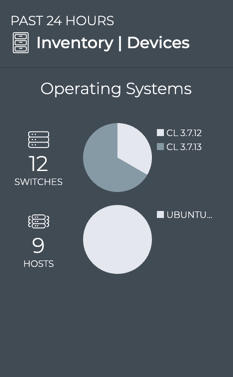
- Hover over the pie charts to view the total number of devices with a given operating system installed.
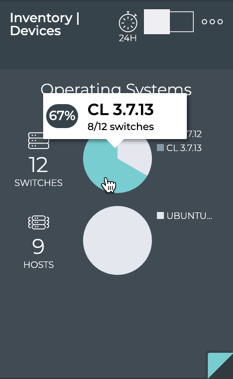
-
Change to the large card using the size picker.
-
Hover over a segment in the OS distribution chart to view the total number of devices with a given operating system installed.
Note that sympathetic highlighting (in blue) is employed to show which versions of the other switch components are associated with this OS.
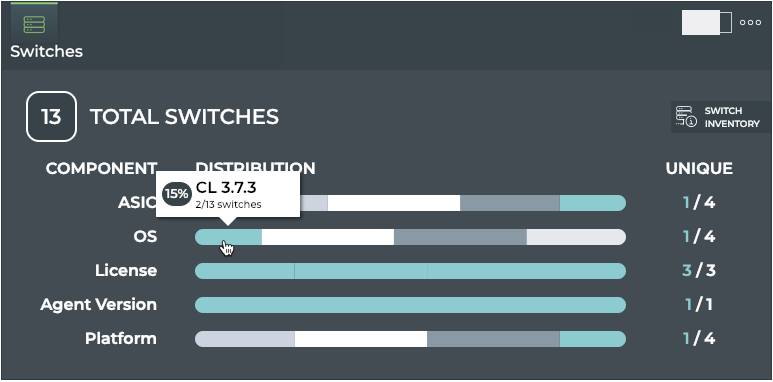
-
Click on a segment in OS distribution chart.
-
Click Filter OS at the top of the popup.

- The card updates to show only the components associated with switches running the selected OS. To return to all OSs, click X in the OS tag to remove the filter.

- Change to the full-screen card using the size picker.

-
The All Switches tab is selected by default. Scroll to the right to locate all of the OS parameter data.
-
Click All Hosts to view the OS parameters for all host servers.

- To return to your workbench, click
in the top right corner of the card.
-
Locate the Inventory|Switches card on your workbench.
-
Hover over a segment of the OS graph in the distribution chart.
The same information is available on the summary tab of the large size card.

-
Hover over the card, and change to the full-screen card using the size picker.
-
Click OS.

- To return to your workbench, click
in the top right corner of the card.
To view OS information for your switches and host servers, run:
netq show inventory os [version <os-version>|name <os-name>] [json]
This example shows the OS information for all devices.
cumulus@switch:~$ netq show inventory os
Matching inventory records:
Hostname Name Version Last Changed
----------------- --------------- ------------------------------------ -------------------------
border01 CL 3.7.13 Tue Jul 28 18:49:46 2020
border02 CL 3.7.13 Tue Jul 28 18:44:42 2020
fw1 CL 3.7.13 Tue Jul 28 19:14:27 2020
fw2 CL 3.7.13 Tue Jul 28 19:12:50 2020
leaf01 CL 3.7.13 Wed Jul 29 16:12:20 2020
leaf02 CL 3.7.13 Wed Jul 29 16:12:21 2020
leaf03 CL 3.7.13 Tue Jul 14 21:18:21 2020
leaf04 CL 3.7.13 Tue Jul 14 20:58:47 2020
oob-mgmt-server Ubuntu 18.04 Mon Jul 13 21:01:35 2020
server01 Ubuntu 18.04 Mon Jul 13 22:09:18 2020
server02 Ubuntu 18.04 Mon Jul 13 22:09:18 2020
server03 Ubuntu 18.04 Mon Jul 13 22:09:20 2020
server04 Ubuntu 18.04 Mon Jul 13 22:09:20 2020
server05 Ubuntu 18.04 Mon Jul 13 22:09:20 2020
server06 Ubuntu 18.04 Mon Jul 13 22:09:21 2020
server07 Ubuntu 18.04 Mon Jul 13 22:09:21 2020
server08 Ubuntu 18.04 Mon Jul 13 22:09:22 2020
spine01 CL 3.7.12 Mon Aug 10 19:55:06 2020
spine02 CL 3.7.12 Mon Aug 10 19:55:07 2020
spine03 CL 3.7.12 Mon Aug 10 19:55:09 2020
spine04 CL 3.7.12 Mon Aug 10 19:55:08 2020
You can filter the results of the command to view only devices with a particular operating system or version. This can be especially helpful when you suspect that a particular device has not been upgraded as expected.
This example shows all devices with the Cumulus Linux version 3.7.12 installed.
cumulus@switch:~$ netq show inventory os version 3.7.12
Matching inventory records:
Hostname Name Version Last Changed
----------------- --------------- ------------------------------------ -------------------------
spine01 CL 3.7.12 Mon Aug 10 19:55:06 2020
spine02 CL 3.7.12 Mon Aug 10 19:55:07 2020
spine03 CL 3.7.12 Mon Aug 10 19:55:09 2020
spine04 CL 3.7.12 Mon Aug 10 19:55:08 2020
View Cumulus Linux License Information
The state of a Cumulus Linux license can impact the function of your switches. If the license status is Bad or Missing, the license must be updated or applied for a switch to operate properly. Hosts do not require a Cumulus Linux or NetQ license.
Cumulus Linux license information is available from the NetQ UI and NetQ CLI.
- Inventory|Devices card
- Large: view the distribution of license state across all switches (graphic)
- Full-screen: view license state across all switches (table)
- Inventory|Switches card
- Medium/Large: view the distribution of license state across all switches (graphic)
- Full-screen: view license state across all switches (table)
netq show inventory license- View license name and state across all devices
-
Locate the Inventory|Devices card on your workbench.
-
Change to the large card using the size picker.

-
Hover over the distribution chart for license to view the total number of devices with a given license installed.
-
Alternately, change to the full-screen card using the size picker.

-
Scroll to the right to locate the License State and License Name columns. Based on these values:
- OK: no action is required
- Bad: validate the correct license is installed and has not expired
- Missing: install a valid Cumulus Linux license
- N/A: This device does not require a license; typically a host.
-
To return to your workbench, click
in the top right corner of the card.
-
Locate the medium Inventory|Switches card on your workbench.
-
Hover over a segment of the license graph in the distribution chart.
The same information is available on the summary tab of the large size card.

-
Hover over the card, and change to the full-screen card using the size picker.
-
The Show All tab is displayed by default. Scroll to the right to locate the License State and License Name columns. Based on the state values:
- OK: no action is required
- Bad: validate the correct license is installed and has not expired
- Missing: install a valid Cumulus Linux license
- N/A: This device does not require a license; typically a host.
-
To return to your workbench, click
in the top right corner of the card.
To view license information for your switches, run:
netq show inventory license [cumulus] [status ok | status missing] [around <text-time>] [json]
Use the cumulus option to list only Cumulus Linux licenses. Use the status option to list only the switches with that status.
This example shows the license information for all switches.
cumulus@switch:~$ netq show inventory license
Matching inventory records:
Hostname Name State Last Changed
----------------- --------------- ---------- -------------------------
border01 Cumulus Linux missing Tue Jul 28 18:49:46 2020
border02 Cumulus Linux missing Tue Jul 28 18:44:42 2020
fw1 Cumulus Linux missing Tue Jul 28 19:14:27 2020
fw2 Cumulus Linux missing Tue Jul 28 19:12:50 2020
leaf01 Cumulus Linux missing Wed Jul 29 16:12:20 2020
leaf02 Cumulus Linux missing Wed Jul 29 16:12:21 2020
leaf03 Cumulus Linux missing Tue Jul 14 21:18:21 2020
leaf04 Cumulus Linux missing Tue Jul 14 20:58:47 2020
oob-mgmt-server Cumulus Linux N/A Mon Jul 13 21:01:35 2020
server01 Cumulus Linux N/A Mon Jul 13 22:09:18 2020
server02 Cumulus Linux N/A Mon Jul 13 22:09:18 2020
server03 Cumulus Linux N/A Mon Jul 13 22:09:20 2020
server04 Cumulus Linux N/A Mon Jul 13 22:09:20 2020
server05 Cumulus Linux N/A Mon Jul 13 22:09:20 2020
server06 Cumulus Linux N/A Mon Jul 13 22:09:21 2020
server07 Cumulus Linux N/A Mon Jul 13 22:09:21 2020
server08 Cumulus Linux N/A Mon Jul 13 22:09:22 2020
spine01 Cumulus Linux missing Mon Aug 10 19:55:06 2020
spine02 Cumulus Linux missing Mon Aug 10 19:55:07 2020
spine03 Cumulus Linux missing Mon Aug 10 19:55:09 2020
spine04 Cumulus Linux missing Mon Aug 10 19:55:08 2020
Based on the state value:
- OK: no action is required
- Bad: validate the correct license is installed and has not expired
- Missing: install a valid Cumulus Linux license
- N/A: This device does not require a license; typically a host.
You can view the historical state of licenses using the around keyword. This example shows the license state for all devices about 7 days ago. Remember to use measurement units on the time values.
cumulus@switch:~$ netq show inventory license around 7d
Matching inventory records:
Hostname Name State Last Changed
----------------- --------------- ---------- -------------------------
edge01 Cumulus Linux N/A Tue Apr 2 14:01:18 2019
exit01 Cumulus Linux ok Tue Apr 2 14:01:13 2019
exit02 Cumulus Linux ok Tue Apr 2 14:01:38 2019
leaf01 Cumulus Linux ok Tue Apr 2 20:07:09 2019
leaf02 Cumulus Linux ok Tue Apr 2 14:01:46 2019
leaf03 Cumulus Linux ok Tue Apr 2 14:01:41 2019
leaf04 Cumulus Linux ok Tue Apr 2 14:01:32 2019
server01 Cumulus Linux N/A Tue Apr 2 14:01:55 2019
server02 Cumulus Linux N/A Tue Apr 2 14:01:55 2019
server03 Cumulus Linux N/A Tue Apr 2 14:01:55 2019
server04 Cumulus Linux N/A Tue Apr 2 14:01:55 2019
spine01 Cumulus Linux ok Tue Apr 2 14:01:49 2019
spine02 Cumulus Linux ok Tue Apr 2 14:01:05 2019
View the Supported Cumulus Linux Packages
When you are troubleshooting an issue with a switch, you might want to know what versions of the Cumulus Linux operating system are supported on that switch and on a switch that is not having the same issue.
To view package information for your switches, run:
netq show cl-manifest [json]
This example shows the OS packages supported for all switches.
cumulus@switch:~$ netq show cl-manifest
Matching manifest records:
Hostname ASIC Vendor CPU Arch Manifest Version
----------------- -------------------- -------------------- --------------------
border01 vx x86_64 3.7.6.1
border01 vx x86_64 3.7.10
border01 vx x86_64 3.7.11
border01 vx x86_64 3.6.2.1
...
fw1 vx x86_64 3.7.6.1
fw1 vx x86_64 3.7.10
fw1 vx x86_64 3.7.11
fw1 vx x86_64 3.6.2.1
...
leaf01 vx x86_64 4.1.0
leaf01 vx x86_64 4.0.0
leaf01 vx x86_64 3.6.2
leaf01 vx x86_64 3.7.2
...
leaf02 vx x86_64 3.7.6.1
leaf02 vx x86_64 3.7.10
leaf02 vx x86_64 3.7.11
leaf02 vx x86_64 3.6.2.1
...
View All Software Packages Installed
If you are having an issue with several switches, you may want to verify what software packages are installed on them and compare that to the recommended packages for a given Cumulus Linux release.
To view installed package information for your switches, run:
netq show cl-pkg-info [<text-package-name>] [around <text-time>] [json]
Use the text-package-name option to narrow the results to a particular package or the around option to narrow the output to a particular time range.
This example shows all installed software packages for all devices.
cumulus@switch:~$ netq show cl-pkg-info
Matching package_info records:
Hostname Package Name Version CL Version Package Status Last Changed
----------------- ------------------------ -------------------- -------------------- -------------------- -------------------------
border01 libcryptsetup4 2:1.6.6-5 Cumulus Linux 3.7.13 installed Mon Aug 17 18:53:50 2020
border01 libedit2 3.1-20140620-2 Cumulus Linux 3.7.13 installed Mon Aug 17 18:53:50 2020
border01 libffi6 3.1-2+deb8u1 Cumulus Linux 3.7.13 installed Mon Aug 17 18:53:50 2020
...
border02 libdb5.3 9999-cl3u2 Cumulus Linux 3.7.13 installed Mon Aug 17 18:48:53 2020
border02 libnl-cli-3-200 3.2.27-cl3u15+1 Cumulus Linux 3.7.13 installed Mon Aug 17 18:48:53 2020
border02 pkg-config 0.28-1 Cumulus Linux 3.7.13 installed Mon Aug 17 18:48:53 2020
border02 libjs-sphinxdoc 1.2.3+dfsg-1 Cumulus Linux 3.7.13 installed Mon Aug 17 18:48:53 2020
...
fw1 libpcap0.8 1.8.1-3~bpo8+1 Cumulus Linux 3.7.13 installed Mon Aug 17 19:18:57 2020
fw1 python-eventlet 0.13.0-2 Cumulus Linux 3.7.13 installed Mon Aug 17 19:18:57 2020
fw1 libapt-pkg4.12 1.0.9.8.5-cl3u2 Cumulus Linux 3.7.13 installed Mon Aug 17 19:18:57 2020
fw1 libopts25 1:5.18.4-3 Cumulus Linux 3.7.13 installed Mon Aug 17 19:18:57 2020
...
This example shows the installed switchd package version.
cumulus@switch:~$ netq spine01 show cl-pkg-info switchd
Matching package_info records:
Hostname Package Name Version CL Version Package Status Last Changed
----------------- ------------------------ -------------------- -------------------- -------------------- -------------------------
spine01 switchd 1.0-cl3u40 Cumulus Linux 3.7.12 installed Thu Aug 27 01:58:47 2020
View Recommended Software Packages
You can determine whether any of your switches are using a software package other than the default package associated with the Cumulus Linux release that is running on the switches. Use this list to determine which packages to install/upgrade on all devices. Additionally, you can determine if a software package is missing.
To view recommended package information for your switches, run:
netq show recommended-pkg-version [release-id <text-release-id>] [package-name <text-package-name>] [json]
The output may be rather lengthy if this command is run for all releases and packages. If desired, run the command using the release-id and/or package-name options to shorten the output.
This example looks for switches running Cumulus Linux 3.7.1 and switchd. The result is a single switch, leaf12, that has older software and is recommended for update.
cumulus@switch:~$ netq show recommended-pkg-version release-id 3.7.1 package-name switchd
Matching manifest records:
Hostname Release ID ASIC Vendor CPU Arch Package Name Version Last Changed
----------------- -------------------- -------------------- -------------------- -------------------- -------------------- -------------------------
leaf12 3.7.1 vx x86_64 switchd 1.0-cl3u30 Wed Feb 5 04:36:30 2020
This example looks for switches running Cumulus Linux 3.7.1 and ptmd. The result is a single switch, server01, that has older software and is recommended for update.
cumulus@switch:~$ netq show recommended-pkg-version release-id 3.7.1 package-name ptmd
Matching manifest records:
Hostname Release ID ASIC Vendor CPU Arch Package Name Version Last Changed
----------------- -------------------- -------------------- -------------------- -------------------- -------------------- -------------------------
server01 3.7.1 vx x86_64 ptmd 3.0-2-cl3u8 Wed Feb 5 04:36:30 2020
This example looks for switches running Cumulus Linux 3.7.1 and lldpd. The result is a single switch, server01, that has older software and is recommended for update.
cumulus@switch:~$ netq show recommended-pkg-version release-id 3.7.1 package-name lldpd
Matching manifest records:
Hostname Release ID ASIC Vendor CPU Arch Package Name Version Last Changed
----------------- -------------------- -------------------- -------------------- -------------------- -------------------- -------------------------
server01 3.7.1 vx x86_64 lldpd 0.9.8-0-cl3u11 Wed Feb 5 04:36:30 2020
This example looks for switches running Cumulus Linux 3.6.2 and switchd. The result is a single switch, leaf04, that has older software and is recommended for update.
cumulus@noc-pr:~$ netq show recommended-pkg-version release-id 3.6.2 package-name switchd
Matching manifest records:
Hostname Release ID ASIC Vendor CPU Arch Package Name Version Last Changed
----------------- -------------------- -------------------- -------------------- -------------------- -------------------- -------------------------
leaf04 3.6.2 vx x86_64 switchd 1.0-cl3u27 Wed Feb 5 04:36:30 2020
View ACL Resources
Using the NetQ CLI, you can monitor the incoming and outgoing access control lists (ACLs) configured on all switches, currently or at a time in the past.
To view ACL resources for all of your switches, run:
netq show cl-resource acl [ingress | egress] [around <text-time>] [json]
Use the egress or ingress options to show only the outgoing or incoming ACLs. Use the around option to show this information for a time in the past.
This example shows the ACL resources for all configured switches:
cumulus@switch:~$ netq show cl-resource acl
Matching cl_resource records:
Hostname In IPv4 filter In IPv4 Mangle In IPv6 filter In IPv6 Mangle In 8021x filter In Mirror In PBR IPv4 filter In PBR IPv6 filter Eg IPv4 filter Eg IPv4 Mangle Eg IPv6 filter Eg IPv6 Mangle ACL Regions 18B Rules Key 32B Rules Key 54B Rules Key L4 Port range Checke Last Updated
rs
----------------- -------------------- -------------------- -------------------- -------------------- -------------------- -------------------- -------------------- -------------------- -------------------- -------------------- -------------------- -------------------- -------------------- -------------------- -------------------- -------------------- -------------------- ------------------------
act-5712-09 40,512(7%) 0,0(0%) 30,768(3%) 0,0(0%) 0,0(0%) 0,0(0%) 0,0(0%) 0,0(0%) 32,256(12%) 0,0(0%) 0,0(0%) 0,0(0%) 0,0(0%) 0,0(0%) 0,0(0%) 0,0(0%) 2,24(8%) Tue Aug 18 20:20:39 2020
mlx-2700-04 0,0(0%) 0,0(0%) 0,0(0%) 0,0(0%) 0,0(0%) 0,0(0%) 0,0(0%) 0,0(0%) 0,0(0%) 0,0(0%) 0,0(0%) 0,0(0%) 4,400(1%) 2,2256(0%) 0,1024(0%) 2,1024(0%) 0,0(0%) Tue Aug 18 20:19:08 2020
The same information can be output to JSON format:
cumulus@noc-pr:~$ netq show cl-resource acl json
{
"cl_resource":[
{
"egIpv6Mangle":"0,0(0%)",
"egIpv6Filter":"0,0(0%)",
"inIpv6Mangle":"0,0(0%)",
"egIpv4Mangle":"0,0(0%)",
"egIpv4Filter":"32,256(12%)",
"inIpv4Mangle":"0,0(0%)",
"in8021XFilter":"0,0(0%)",
"inPbrIpv4Filter":"0,0(0%)",
"inPbrIpv6Filter":"0,0(0%)",
"l4PortRangeCheckers":"2,24(8%)",
"lastUpdated":1597782039.632999897,
"inMirror":"0,0(0%)",
"hostname":"act-5712-09",
"54bRulesKey":"0,0(0%)",
"18bRulesKey":"0,0(0%)",
"32bRulesKey":"0,0(0%)",
"inIpv6Filter":"30,768(3%)",
"aclRegions":"0,0(0%)",
"inIpv4Filter":"40,512(7%)"
},
{
"egIpv6Mangle":"0,0(0%)",
"egIpv6Filter":"0,0(0%)",
"inIpv6Mangle":"0,0(0%)",
"egIpv4Mangle":"0,0(0%)",
"egIpv4Filter":"0,0(0%)",
"inIpv4Mangle":"0,0(0%)",
"in8021XFilter":"0,0(0%)",
"inPbrIpv4Filter":"0,0(0%)",
"inPbrIpv6Filter":"0,0(0%)",
"l4PortRangeCheckers":"0,0(0%)",
"lastUpdated":1597781948.3259999752,
"inMirror":"0,0(0%)",
"hostname":"mlx-2700-04",
"54bRulesKey":"2,1024(0%)",
"18bRulesKey":"2,2256(0%)",
"32bRulesKey":"0,1024(0%)",
"inIpv6Filter":"0,0(0%)",
"aclRegions":"4,400(1%)",
"inIpv4Filter":"0,0(0%)"
}
],
"truncatedResult":false
}
View Forwarding Resources
With the NetQ CLI, you can monitor the amount of forwarding resources used by all devices, currently or at a time in the past.
To view forwarding resources for all of your switches, run:
netq show cl-resource forwarding [around <text-time>] [json]
Use the around option to show this information for a time in the past.
This example shows forwarding resources for all configured switches:
cumulus@noc-pr:~$ netq show cl-resource forwarding
Matching cl_resource records:
Hostname IPv4 host entries IPv6 host entries IPv4 route entries IPv6 route entries ECMP nexthops MAC entries Total Mcast Routes Last Updated
----------------- -------------------- -------------------- -------------------- -------------------- -------------------- -------------------- -------------------- ------------------------
act-5712-09 0,16384(0%) 0,0(0%) 0,131072(0%) 23,20480(0%) 0,16330(0%) 0,32768(0%) 0,8192(0%) Tue Aug 18 20:20:39 2020
mlx-2700-04 0,32768(0%) 0,16384(0%) 0,65536(0%) 4,28672(0%) 0,4101(0%) 0,40960(0%) 0,1000(0%) Tue Aug 18 20:19:08 2020
View NetQ Agents
NetQ Agent information is available from the NetQ UI and NetQ CLI.
- Agents list
- Full-screen: view NetQ Agent version across all devices (table)
- Inventory|Switches card
- Medium: view the number of unique versions of the NetQ Agent running on all devices
- Large: view the number of unique versions of the NetQ Agent running on all devices and the associated OS
- Full-screen: view NetQ Agent status and version across all devices
netq show agents- View NetQ Agent status, uptime, and version across all devices
To view the NetQ Agents on all switches and hosts:
-
Click
to open the Main menu.
-
Select Agents from the Network column.
-
View the Version column to determine which release of the NetQ Agent is running on your devices. Ideally, this version should be the same as the NetQ release you are running, and is the same across all of your devices.
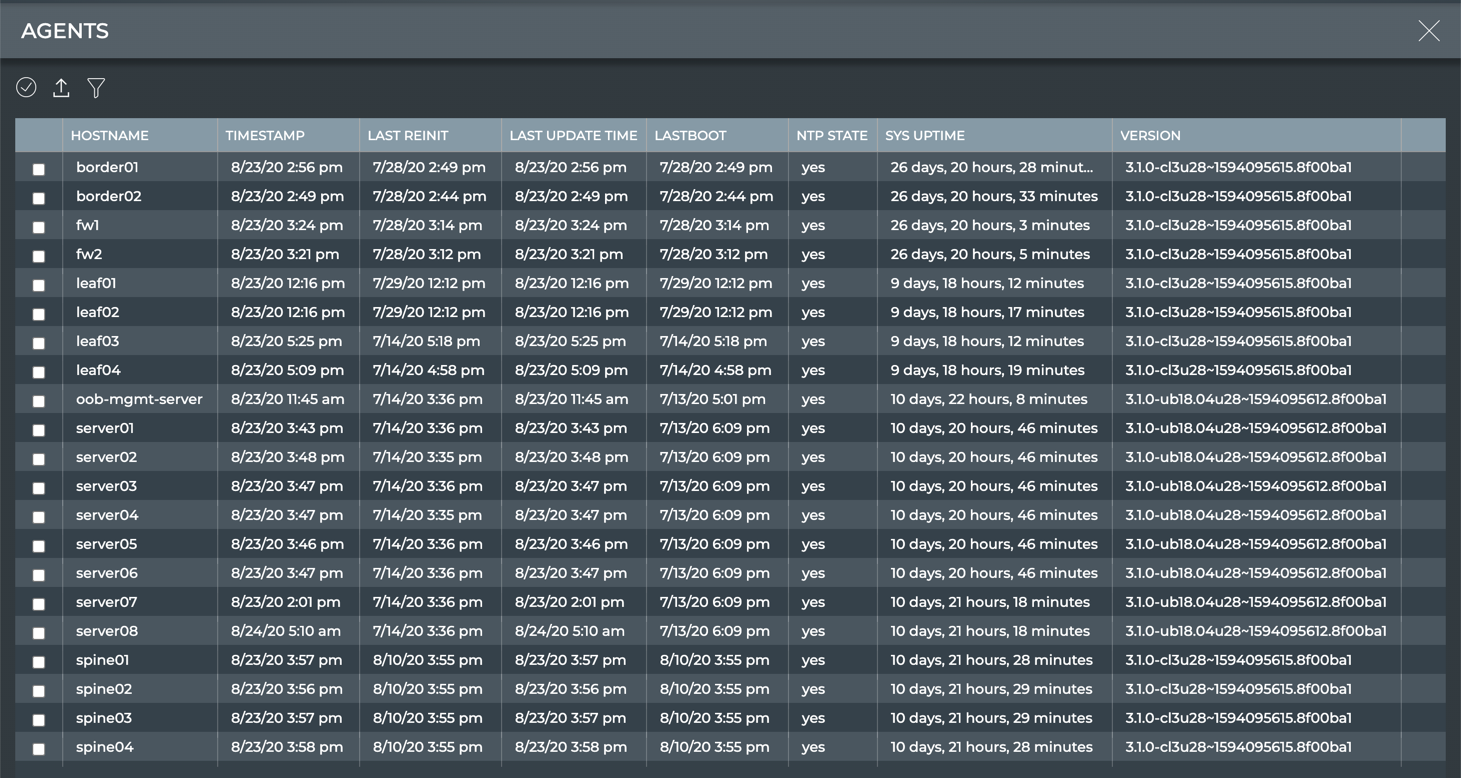
| Parameter | Description |
|---|---|
| Hostname | Name of the switch or host |
| Timestamp | Date and time the data was captured |
| Last Reinit | Date and time that the switch or host was reinitialized |
| Last Update Time | Date and time that the switch or host was updated |
| Lastboot | Date and time that the switch or host was last booted up |
| NTP State | Status of NTP synchronization on the switch or host; yes = in synchronization, no = out of synchronization |
| Sys Uptime | Amount of time the switch or host has been continuously up and running |
| Version | NetQ version running on the switch or host |
It is recommended that when you upgrade NetQ that you also upgrade the NetQ Agents. You can determine if you have covered all of your agents using the medium or large Switch Inventory card. To view the NetQ Agent distribution by version:
-
Open the medium Switch Inventory card.
-
View the number in the Unique column next to Agent.
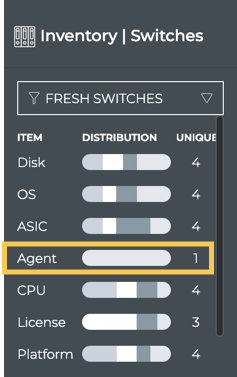
-
If the number is greater than one, you have multiple NetQ Agent versions deployed.
-
If you have multiple versions, hover over the Agent chart to view the count of switches using each version.
-
For more detail, switch to the large Switch Inventory card.
-
Hover over the card and click
to open the Software tab.
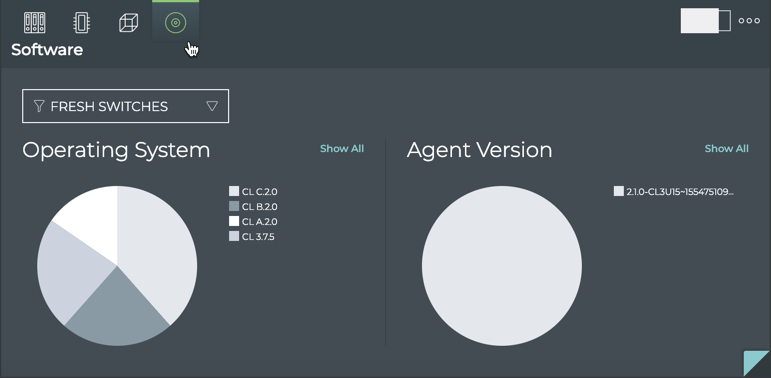
-
Hover over the chart on the right to view the number of switches using the various versions of the NetQ Agent.
-
Hover over the Operating System chart to see which NetQ Agent versions are being run on each OS.
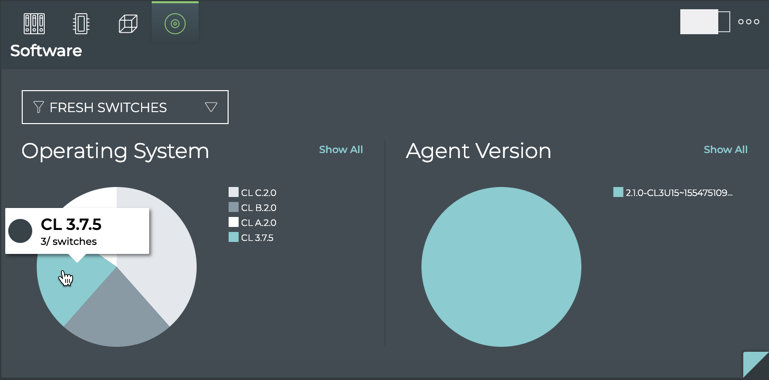
-
Click either chart to focus on a particular OS or agent version.
-
To return to the full view, click
in the filter tag.
-
Filter the data on the card by switches that are having trouble communicating, by selecting Rotten Switches from the dropdown above the charts.
-
Open the full screen Inventory|Switches card. The Show All tab is displayed by default, and shows the NetQ Agent status and version for all devices.

To view the NetQ Agents on all switches and hosts, run:
netq show agents [fresh | rotten ] [around <text-time>] [json]
Use the fresh keyword to view only the NetQ Agents that are in current communication with the NetQ Platform or NetQ Collector. Use the rotten keyword to view those that are not. Use the around keyword to view the state of NetQ Agents at an earlier time.
This example shows the current NetQ Agent state on all devices. View the Status column which indicates whether the agent is up and current, labelled Fresh, or down and stale, labelled Rotten. Additional information is provided about the agent status, including whether it is time synchronized, how long it has been up, and the last time its state changed. You can also see the version running. Ideally, this version should be the same as the NetQ release you are running, and is the same across all of your devices.
cumulus@switch:~$ netq show agents
Matching agents records:
Hostname Status NTP Sync Version Sys Uptime Agent Uptime Reinitialize Time Last Changed
----------------- ---------------- -------- ------------------------------------ ------------------------- ------------------------- -------------------------- -------------------------
border01 Fresh yes 3.1.0-cl3u28~1594095615.8f00ba1 Tue Jul 28 18:48:31 2020 Tue Jul 28 18:49:46 2020 Tue Jul 28 18:49:46 2020 Sun Aug 23 18:56:56 2020
border02 Fresh yes 3.1.0-cl3u28~1594095615.8f00ba1 Tue Jul 28 18:43:29 2020 Tue Jul 28 18:44:42 2020 Tue Jul 28 18:44:42 2020 Sun Aug 23 18:49:57 2020
fw1 Fresh yes 3.1.0-cl3u28~1594095615.8f00ba1 Tue Jul 28 19:13:26 2020 Tue Jul 28 19:14:28 2020 Tue Jul 28 19:14:28 2020 Sun Aug 23 19:24:01 2020
fw2 Fresh yes 3.1.0-cl3u28~1594095615.8f00ba1 Tue Jul 28 19:11:27 2020 Tue Jul 28 19:12:51 2020 Tue Jul 28 19:12:51 2020 Sun Aug 23 19:21:13 2020
leaf01 Fresh yes 3.1.0-cl3u28~1594095615.8f00ba1 Tue Jul 14 21:04:03 2020 Wed Jul 29 16:12:22 2020 Wed Jul 29 16:12:22 2020 Sun Aug 23 16:16:09 2020
leaf02 Fresh yes 3.1.0-cl3u28~1594095615.8f00ba1 Tue Jul 14 20:59:10 2020 Wed Jul 29 16:12:23 2020 Wed Jul 29 16:12:23 2020 Sun Aug 23 16:16:48 2020
leaf03 Fresh yes 3.1.0-cl3u28~1594095615.8f00ba1 Tue Jul 14 21:04:03 2020 Tue Jul 14 21:18:23 2020 Tue Jul 14 21:18:23 2020 Sun Aug 23 21:25:16 2020
leaf04 Fresh yes 3.1.0-cl3u28~1594095615.8f00ba1 Tue Jul 14 20:57:30 2020 Tue Jul 14 20:58:48 2020 Tue Jul 14 20:58:48 2020 Sun Aug 23 21:09:06 2020
oob-mgmt-server Fresh yes 3.1.0-ub18.04u28~1594095612.8f00ba1 Mon Jul 13 17:07:59 2020 Mon Jul 13 21:01:35 2020 Tue Jul 14 19:36:19 2020 Sun Aug 23 15:45:05 2020
server01 Fresh yes 3.1.0-ub18.04u28~1594095612.8f00ba1 Mon Jul 13 18:30:46 2020 Mon Jul 13 22:09:19 2020 Tue Jul 14 19:36:22 2020 Sun Aug 23 19:43:34 2020
server02 Fresh yes 3.1.0-ub18.04u28~1594095612.8f00ba1 Mon Jul 13 18:30:46 2020 Mon Jul 13 22:09:19 2020 Tue Jul 14 19:35:59 2020 Sun Aug 23 19:48:07 2020
server03 Fresh yes 3.1.0-ub18.04u28~1594095612.8f00ba1 Mon Jul 13 18:30:46 2020 Mon Jul 13 22:09:20 2020 Tue Jul 14 19:36:22 2020 Sun Aug 23 19:47:47 2020
server04 Fresh yes 3.1.0-ub18.04u28~1594095612.8f00ba1 Mon Jul 13 18:30:46 2020 Mon Jul 13 22:09:20 2020 Tue Jul 14 19:35:59 2020 Sun Aug 23 19:47:52 2020
server05 Fresh yes 3.1.0-ub18.04u28~1594095612.8f00ba1 Mon Jul 13 18:30:46 2020 Mon Jul 13 22:09:20 2020 Tue Jul 14 19:36:02 2020 Sun Aug 23 19:46:27 2020
server06 Fresh yes 3.1.0-ub18.04u28~1594095612.8f00ba1 Mon Jul 13 18:30:46 2020 Mon Jul 13 22:09:21 2020 Tue Jul 14 19:36:37 2020 Sun Aug 23 19:47:37 2020
server07 Fresh yes 3.1.0-ub18.04u28~1594095612.8f00ba1 Mon Jul 13 17:58:02 2020 Mon Jul 13 22:09:21 2020 Tue Jul 14 19:36:01 2020 Sun Aug 23 18:01:08 2020
server08 Fresh yes 3.1.0-ub18.04u28~1594095612.8f00ba1 Mon Jul 13 17:58:18 2020 Mon Jul 13 22:09:23 2020 Tue Jul 14 19:36:03 2020 Mon Aug 24 09:10:38 2020
spine01 Fresh yes 3.1.0-cl3u28~1594095615.8f00ba1 Mon Jul 13 17:48:43 2020 Mon Aug 10 19:55:07 2020 Mon Aug 10 19:55:07 2020 Sun Aug 23 19:57:05 2020
spine02 Fresh yes 3.1.0-cl3u28~1594095615.8f00ba1 Mon Jul 13 17:47:39 2020 Mon Aug 10 19:55:09 2020 Mon Aug 10 19:55:09 2020 Sun Aug 23 19:56:39 2020
spine03 Fresh yes 3.1.0-cl3u28~1594095615.8f00ba1 Mon Jul 13 17:47:40 2020 Mon Aug 10 19:55:12 2020 Mon Aug 10 19:55:12 2020 Sun Aug 23 19:57:29 2020
spine04 Fresh yes 3.1.0-cl3u28~1594095615.8f00ba1 Mon Jul 13 17:47:56 2020 Mon Aug 10 19:55:11 2020 Mon Aug 10 19:55:11 2020 Sun Aug 23 19:58:23 2020